 Are you thinking about setting up an e-commerce site or making goods available for sale to a global customer base? If so, then here’s a great idea: consider providing users with currency conversion.
Are you thinking about setting up an e-commerce site or making goods available for sale to a global customer base? If so, then here’s a great idea: consider providing users with currency conversion.
Currency conversion software lets your prospects have the cost of a foreign currency amount converted to their local currency at the purchase or checkout phase. It also lets visitors and customers see the exact amount their card or PayPal account will be charged, expressed in their local currency.
One great advantage of adding currency conversion to your website is that it lets customers view and understand pricing in foreign countries in their own home currency, and makes it easier for visitors to calculate their costs and expenses.
Fortunately, if you are a WordPress user, it’s really simple to add currency conversion via a plugin to currency conversion to WordPress using a plugin, allowing your visitors to easily determine the cost of your goods.
Currencyr – Free Currency Conversion Plugin For WP Websites
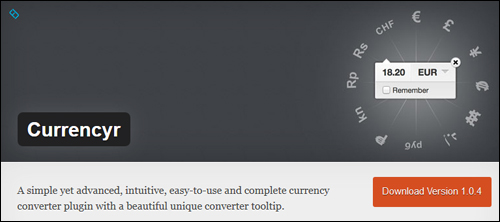
Currencyr is a simple yet advanced, intuitive, easy-to-use and complete currency converter plugin with a unique converter tooltip. It’s also free!
This currency conversion plugin includes a number of great features such as:
- Inline conversion tool
- Supports several exchange rates providers, like Yahoo!, Google, Open Exchange Rates, European Central Bank and FoxRates
- WP-Cron task scheduler enabled
- Widgetized currency table and converter
- Supports integration with various e-commerce plugins such as WooCommerce, WP-eCommerce, Shopp, and Easy Digital Downloads.
- Automatic local currency determination
- Supports full language translations
Important: This plugin needs PHP 5.3.0 or later. Do not install this plugin if you currently have an older version of PHP installed on your server. Ask your web host to check and upgrade your PHP.
***
You can install the currency conversion plugin from your WordPress admin area by searching for “currencyr” in the Plugins section and clicking “Install Now” …
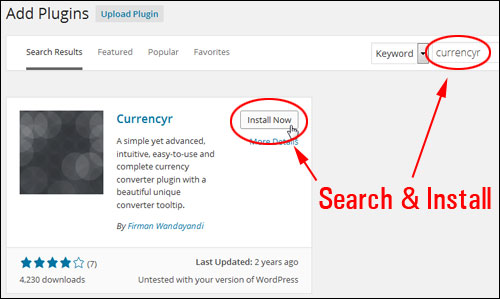
After installing and activating the plugin, you can access the plugin’s settings by selecting Currencyr from your admin user navigation menu …
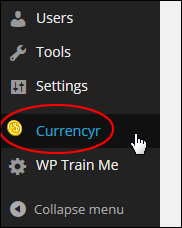
The plugin settings area offers you several configuration options …
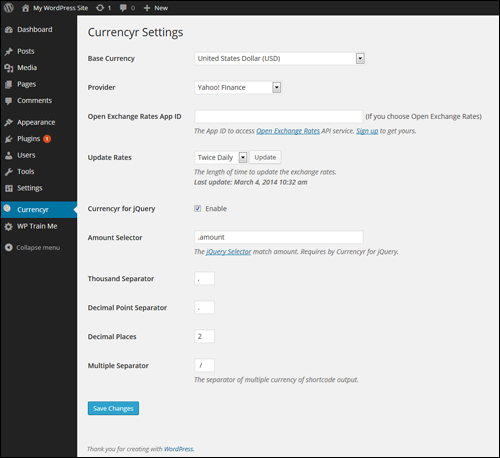
For example, you can choose your base currency from the Base Currency dropdown menu. The default option is (‘USD’) …
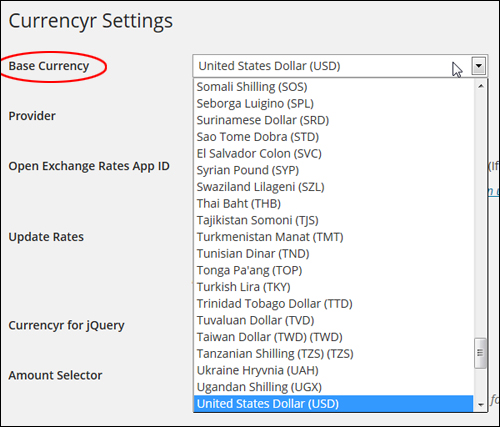
Similarly, you can specify which data provider you want to use from a drop-down menu. The default selection is Yahoo Finance, but you can choose another provider, like European Central Bank, FoxRate, Google Finance or Open Exchange Rates …

Note: If you choose ‘Open Exchange Rates’ as your provider, an API (Application Programming Interface) will be required …

You can choose how often you want the exchange rates to be updated by choosing an option from the ‘Update Rates’ drop-down menu …

The plugin uses jQuery, which is an open-source library of Javascript code that allows web developers to add things like animation effects to web applications (like WP plugins).
Unless there is a reason to change the jQuery settings, leave them as they are …

Configure the remainder of the plugin settings and click the Save Changes button when done …
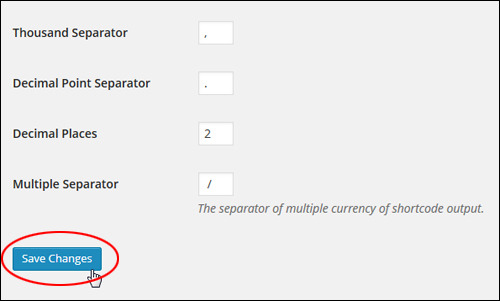
After your plugin settings have been configured, you can start adding currency conversion to WP website’s posts and pages using shortcodes.
See the ‘Additional Plugin Notes’ section at the bottom of this tutorial to learn more about using currency codes (e.g. USD, AUD, JPY, etc …) in this plugin.
Using Currencyr Shortcodes
You can add currency conversion to WP pages, posts and widgets with no coding knowledge or skills using shortcodes.
Let’s take a look at some examples of currency shortcodes that you can add to posts and pages:
Let’s say that you are selling goods on your website for a fixed amount (e.g. $175) in US Dollars (USD), and you want to show the amount converted into British pounds (GBP) on your page.
To do this, simply add the following shortcode into your page content …

Note: You can also add amounts in dollars and cents (for example, 175.00, 79.45, 2499.99, etc …)
The example below shows how your shortcode looks once you have added it to the page …
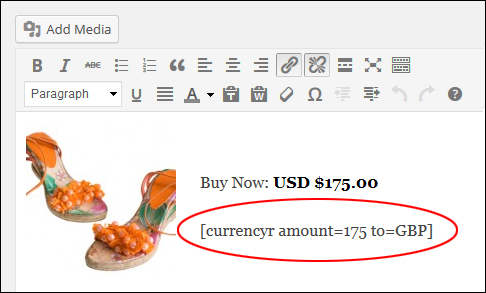
After publishing your post, your currency conversion will display as shown in the example below …

Using the same example, let’s now convert the same price into different currencies.
To do this, use the shortcode below (you can add as many currency symbols as you want separated by vertical pipes) …

You can see how the above shortcode looks when inserted into a page …

Once the page has been published, your converted currency will then appear like this …

See the ‘Additional Plugin Notes’ section below to learn how to change the currency separator symbol in this plugin.
Now, let’s say that you want to use a different base currency than the one selected as the default.
For example, say you have set your default base currency as EUR and you have a section on your website targeted to customers from countries like Australia or Canada, you can change the base currency using the following shortcode …

Here’s how the shortcode looks when added to a post …
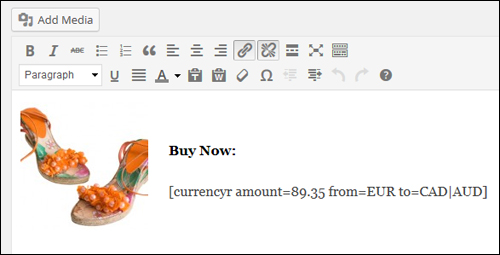
Once the content has been published, the converted currency amounts will then appear as shown below …
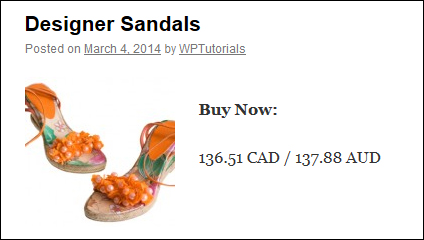
Widget
You can also add currency conversion to your website’s sidebar area using the Currencyr widget.
To add the currency converter to your sidebar, select Appearance > Widgets from your WP dashboard menu …

In the Widgets > Available Widgets area find the ‘Currencyr’ widget and add it to the ‘Active Widgets’ area …

Configure the widget options as shown below (add currency codes separated by a comma), and click ‘Save’ to update your settings …
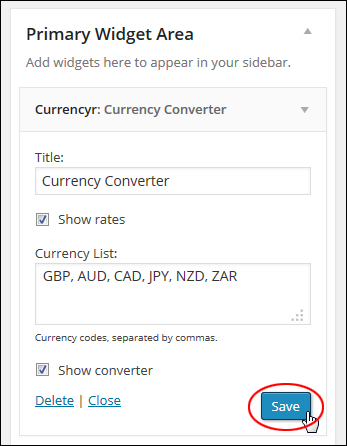
The currency converter will now show on the sidebar with the settings you have selected …
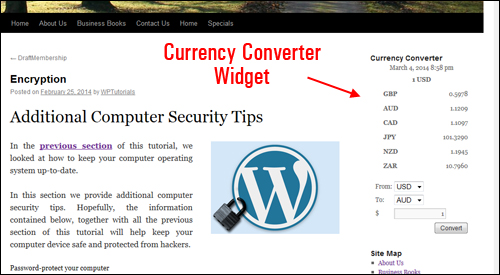
Additional Plugin Notes
Here are some additional notes and useful information about using the Currencyr plugin.
Currency Separator
The Currencyr plugin allows you to specify a symbol of your choice to display as the currency separator when using several currencies.
You can change the symbol in the ‘Multiple Separator’ settings field.
So, for example, entering the default symbol “/” (forward slash) …

Displays your currency values separated by the forward slash as you can see in the example below …
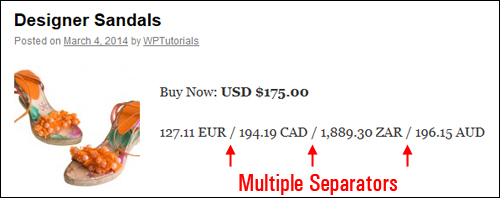
If you select another symbol and resave your settings …

Your site visitors will see the new symbol display as the currency separator …
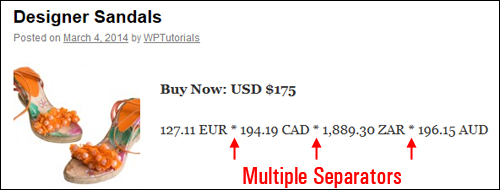
Using The Currencyr Plugin With WP-Compatible e-Commerce Platforms
As described earlier, the Currencyr plugin can be integrated with various WP-compatible e-commerce plugins like WP-eCommerce and Shopp …
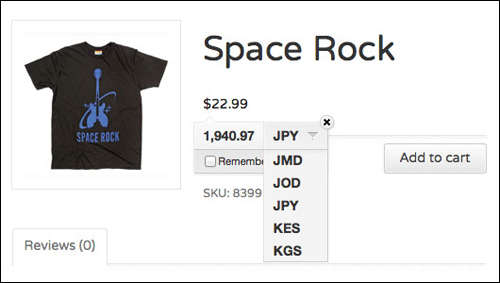
(above image sourced from Currencyr plugin website)
And there you have it! Now you know how to easily add currency conversion to your WordPress site.
To learn more about WordPress e-commerce plugins, see the tutorial below:
***
"I was absolutely amazed at the scope and breadth of these tutorials! The most in-depth training I have ever received on any subject!" - Myke O'Neill, DailyGreenPost.com